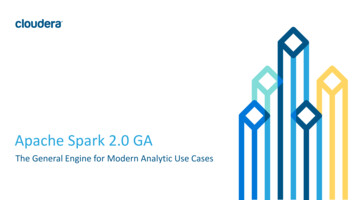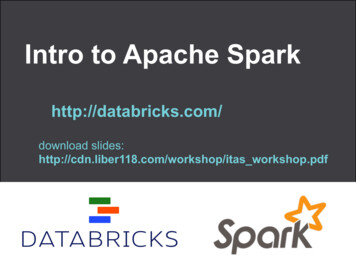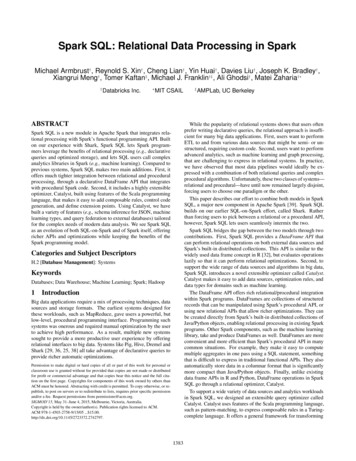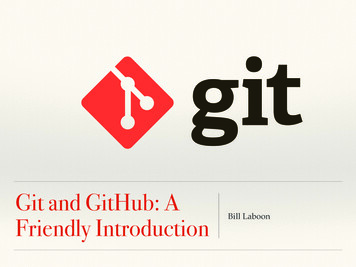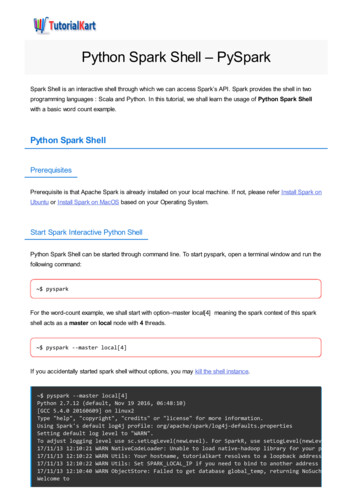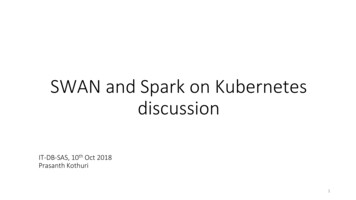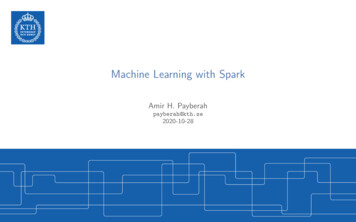
Transcription
Machine Learning with SparkAmir H. Payberahpayberah@kth.se2020-10-28
The Course Web /y6kcpmzy1 / 73
Where Are We?2 / 73
Where Are We?3 / 73
Big Data4 / 73
ProblemITraditional platforms fail to show the expected performance.INeed new systems to store and process large-scale data5 / 73
Scale Up vs. Scale OutIScale up or scale verticallyIScale out or scale horizontally6 / 73
Spark7 / 73
Spark Execution Model (1/3)ISpark applications consist of A driver processA set of executor processes[M. Zaharia et al., Spark:The Definitive Guide, O’Reilly Media, 2018]8 / 73
Spark Execution Model (2/3)IThe driver process is the heart of a Spark applicationISits on a node in the clusterIRuns the main() function9 / 73
Spark Execution Model (3/3)IExecutors execute codes assigned to them by the driver.10 / 73
Spark Programming ModelIJob description based on directed acyclic graphs (DAG).IThere are two types of RDD operators: transformations and actions.11 / 73
Resilient Distributed Datasets (RDD) (1/2)IA distributed memory abstraction.IImmutable collections of objects spread across a cluster. Like a LinkedList MyObjects 12 / 73
Resilient Distributed Datasets (RDD) (2/2)IAn RDD is divided into a number of partitions, which are atomic pieces of information.IPartitions of an RDD can be stored on different nodes of a cluster.13 / 73
Creating RDDsITurn a collection into an RDD.val a sc.parallelize(Array(1, 2, 3))14 / 73
Creating RDDsITurn a collection into an RDD.val a sc.parallelize(Array(1, 2, 3))ILoad text file from local FS, HDFS, or S3.val a sc.textFile("file.txt")val b sc.textFile("directory/*.txt")val c sc.textFile("hdfs://namenode:9000/path/file")14 / 73
RDD OperationsITransformations: lazy operators that create new RDDs.IActions: lunch a computation and return a value to the program or write data to theexternal storage.15 / 73
Spark and Spark SQL16 / 73
DataFrameIA DataFrame is a distributed collection of rows with a homogeneous schema.IIt is equivalent to a table in a relational database.IIt can also be manipulated in similar ways to RDDs.17 / 73
Adding Schema to RDDsISpark RDD: functional transformations on partitioned collections of opaque objects.ISQL DataFrame: declarative transformations on partitioned collections of tuples.18 / 73
Creating a DataFrame - From an RDDIYou can use toDF to convert an RDD to DataFrame.val tupleRDD sc.parallelize(Array(("seif", 65, 0), ("amir", 40, 1)))val tupleDF tupleRDD.toDF("name", "age", "id")19 / 73
Creating a DataFrame - From an RDDIYou can use toDF to convert an RDD to DataFrame.val tupleRDD sc.parallelize(Array(("seif", 65, 0), ("amir", 40, 1)))val tupleDF tupleRDD.toDF("name", "age", "id")IIf RDD contains case class instances, Spark infers the attributes from it.case class Person(name: String, age: Int, id: Int)val peopleRDD sc.parallelize(Array(Person("seif", 65, 0), Person("amir", 40, 1)))val peopleDF peopleRDD.toDF19 / 73
Creating a DataFrame - From Data SourceIData sources supported by Spark. CSV, JSON, Parquet, ORC, JDBC/ODBC connections, Plain-text filesCassandra, HBase, MongoDB, AWS Redshift, XML, etc.val peopleJson spark.read.format("json").load("people.json")val peopleCsv spark.read.format("csv").option("sep", ";").option("inferSchema", "true").option("header", "true").load("people.csv")20 / 73
ColumnIDifferent ways to refer to a column.val people e.col("name")col("name")column("name")’name "name"expr("name")21 / 73
DataFrame Transformations (1/6)Iselect allows to do the DataFrame equivalent of SQL queries on a table of data.people.select("name", "age", "id").show(2)people.select(col("name"), expr("age 3")).show()people.select(expr("name AS username")).show(2)22 / 73
DataFrame Transformations (1/6)Iselect allows to do the DataFrame equivalent of SQL queries on a table of data.people.select("name", "age", "id").show(2)people.select(col("name"), expr("age 3")).show()people.select(expr("name AS username")).show(2)Ifilter and where both filter rows.people.filter(col("age") 20).show()people.where("age 20").show()22 / 73
DataFrame Transformations (1/6)Iselect allows to do the DataFrame equivalent of SQL queries on a table of data.people.select("name", "age", "id").show(2)people.select(col("name"), expr("age 3")).show()people.select(expr("name AS username")).show(2)Ifilter and where both filter rows.people.filter(col("age") 20).show()people.where("age 20").show()Idistinct can be used to extract unique rows.people.select("name").distinct().count()22 / 73
DataFrame Transformations (2/6)IwithColumn adds a new column to a DataFrame.people.withColumn("teenager", expr("age 20")).show()23 / 73
DataFrame Transformations (2/6)IwithColumn adds a new column to a DataFrame.people.withColumn("teenager", expr("age 20")).show()IwithColumnRenamed renames a column.people.withColumnRenamed("name", "username").columns23 / 73
DataFrame Transformations (2/6)IwithColumn adds a new column to a DataFrame.people.withColumn("teenager", expr("age 20")).show()IwithColumnRenamed renames a column.people.withColumnRenamed("name", "username").columnsIdrop removes a column.people.drop("name").columns23 / 73
DataFrame Transformations (3/6)Icount returns the total number of values.people.select(count("age")).show()24 / 73
DataFrame Transformations (3/6)Icount returns the total number of tinct returns the number of unique 24 / 73
DataFrame Transformations (3/6)Icount returns the total number of tinct returns the number of unique Ifirst and last return the first and last value of a DataFrame.people.select(first("name"), last("age")).show()24 / 73
DataFrame Transformations (4/6)Imin and max extract the minimum and maximum values from a DataFrame.people.select(min("name"), max("age"), max("id")).show()25 / 73
DataFrame Transformations (4/6)Imin and max extract the minimum and maximum values from a DataFrame.people.select(min("name"), max("age"), max("id")).show()Isum adds all the values in a column.people.select(sum("age")).show()25 / 73
DataFrame Transformations (4/6)Imin and max extract the minimum and maximum values from a DataFrame.people.select(min("name"), max("age"), max("id")).show()Isum adds all the values in a column.people.select(sum("age")).show()Iavg calculates the average.people.select(avg("age")).show()25 / 73
DataFrame Transformations (5/6)IgroupBy and agg together perform aggregations on ow()26 / 73
DataFrame Transformations (5/6)IgroupBy and agg together perform aggregations on ow()Ijoin performs the join operation between two tables.val t1 spark.createDataFrame(Seq((0, "a", 0), (1, "b", 1), (2, "c", 1))).toDF("num", "name", "id")val t2 spark.createDataFrame(Seq((0, "x"), (1, "y"), (2, "z"))).toDF("id", "group")val joinExpression t1.col("id") t2.col("id")var joinType "inner"t1.join(t2, joinExpression, joinType).show()26 / 73
DataFrame Transformations (6/6)IYou can use udf to define new column-based functions.import org.apache.spark.sql.functions.udfval df spark.createDataFrame(Seq((0, "hello"), (1, "world"))).toDF("id", "text")val upper: String String .toUpperCaseval upperUDF spark.udf.register("upper", upper)df.withColumn("upper", upperUDF(col("text"))).show27 / 73
DataFrame ActionsILike RDDs, DataFrames also have their own set of actions.Icollect: returns an array that contains all the rows in this DataFrame.Icount: returns the number of rows in this DataFrame.Ifirst and head: returns the first row of the DataFrame.Ishow: displays the top 20 rows of the DataFrame in a tabular form.Itake: returns the first n rows of the DataFrame.28 / 73
Machine Learning29 / 73
Machine Learning with SparkISpark provides support for statistics and machine learning. Supervised learningUnsupervised enginesDeep learning30 / 73
Supervised LearningIUsing labeled historical data and training a model to predict the values of those labelsbased on various features of the data points.IClassification (categorical values) IE.g., predicting disease, classifying images, .Regression (continuous values) E.g., predicting sales, predicting height, .31 / 73
Unsupervised LearningINo label to predict.ITrying to find patterns or discover the underlying structure in a given set of data. Clustering, anomaly detection, .32 / 73
The Advanced Analytic ProcessIData collectionIData cleaningIFeature engineeringITraining modelsIModel tuning andevaluation33 / 73
What is MLlib? (1/2)IMLlib is a package built on Spark.IIt provides interfaces for: Gathering and cleaning dataFeature engineering and feature selectionTraining and tuning large-scale supervised and unsupervised machine learning modelsUsing those models in production34 / 73
What is MLlib? (2/2)IMLlib consists of two packages.35 / 73
What is MLlib? (2/2)IMLlib consists of two packages.Iorg.apache.spark.mllib Uses RDDsIt is in maintenance mode (only receives bug fixes, not new features)35 / 73
What is MLlib? (2/2)IMLlib consists of two packages.Iorg.apache.spark.mllib IUses RDDsIt is in maintenance mode (only receives bug fixes, not new features)org.apache.spark.ml Uses DataFramesOffers a high-level interface for building machine learning pipelines35 / 73
High-Level MLlib ConceptsIML pipelines (spark.ml) provide a uniform set of high-level APIs built on top ofDataFrames to create machine learning pipelines.36 / 73
PipelineIPipeline is a sequence of algorithms to process and learn from data.37 / 73
PipelineIPipeline is a sequence of algorithms to process and learn from data.IE.g., a text document processing workflow might include several stages:37 / 73
PipelineIPipeline is a sequence of algorithms to process and learn from data.IE.g., a text document processing workflow might include several stages: Split each document’s text into words.37 / 73
PipelineIPipeline is a sequence of algorithms to process and learn from data.IE.g., a text document processing workflow might include several stages: Split each document’s text into words.Convert each document’s words into a numerical feature vector.37 / 73
PipelineIPipeline is a sequence of algorithms to process and learn from data.IE.g., a text document processing workflow might include several stages: Split each document’s text into words.Convert each document’s words into a numerical feature vector.Learn a prediction model using the feature vectors and labels.37 / 73
PipelineIPipeline is a sequence of algorithms to process and learn from data.IE.g., a text document processing workflow might include several stages: ISplit each document’s text into words.Convert each document’s words into a numerical feature vector.Learn a prediction model using the feature vectors and labels.Main pipeline components: transformers and estimators37 / 73
TransformersITransformers take a DataFrame as input and produce a new DataFrame as output.// transformer: DataFrame [transform] DataFrametransform(dataset: DataFrame): DataFrame38 / 73
TransformersITransformers take a DataFrame as input and produce a new DataFrame as output.IThe class Transformer implements a method transform() that converts oneDataFrame into another.// transformer: DataFrame [transform] DataFrametransform(dataset: DataFrame): DataFrame38 / 73
EstimatorsIEstimator is an abstraction of a learning algorithm that fits a model on a dataset.// estimator: DataFrame [fit] Modelfit(dataset: DataFrame): M39 / 73
EstimatorsIEstimator is an abstraction of a learning algorithm that fits a model on a dataset.IThe class Estimator implements a method fit(), which accepts a DataFrame andproduces a Model (Transformer).// estimator: DataFrame [fit] Modelfit(dataset: DataFrame): M39 / 73
How Does Pipeline Work? (1/3)IA pipeline is a sequence of stages.IStages of a pipeline run in order.40 / 73
How Does Pipeline Work? (1/3)IA pipeline is a sequence of stages.IStages of a pipeline run in order.IThe input DataFrame is transformed as it passes through each stage. Each stage is either a Transformer or an Estimator.40 / 73
How Does Pipeline Work? (1/3)IA pipeline is a sequence of stages.IStages of a pipeline run in order.IThe input DataFrame is transformed as it passes through each stage. IEach stage is either a Transformer or an Estimator.E.g., a Pipeline with three stages: Tokenizer and HashingTF are Transformers, andLogisticRegression is an Estimator.40 / 73
How Does Pipeline Work? (2/3)IPipeline.fit(): is called on the original DataFrame DataFrame with raw text documents and labels41 / 73
How Does Pipeline Work? (2/3)IPipeline.fit(): is called on the original DataFrame IDataFrame with raw text documents and labelsTokenizer.transform(): splits the raw text documents into words Adds a new column with words to the DataFrame41 / 73
How Does Pipeline Work? (2/3)IPipeline.fit(): is called on the original DataFrame ITokenizer.transform(): splits the raw text documents into words IDataFrame with raw text documents and labelsAdds a new column with words to the DataFrameHashingTF.transform(): converts the words column into feature vectors Adds new column with those vectors to the DataFrame41 / 73
How Does Pipeline Work? (2/3)IPipeline.fit(): is called on the original DataFrame ITokenizer.transform(): splits the raw text documents into words IAdds a new column with words to the DataFrameHashingTF.transform(): converts the words column into feature vectors IDataFrame with raw text documents and labelsAdds new column with those vectors to the DataFrameLogisticRegression.fit(): produces a model (LogisticRegressionModel).41 / 73
How Does Pipeline Work? (3/3)IA Pipeline is an Estimator (DataFrame [fit] Model).PipelinePipelineModel42 / 73
How Does Pipeline Work? (3/3)IA Pipeline is an Estimator (DataFrame [fit] Model).IAfter a Pipeline’s fit() runs, it produces a PipelineModel.PipelinePipelineModel42 / 73
How Does Pipeline Work? (3/3)IA Pipeline is an Estimator (DataFrame [fit] Model).IAfter a Pipeline’s fit() runs, it produces a PipelineModel.IPipelineModel is a Transformer (DataFrame [transform] DataFrame).PipelinePipelineModel42 / 73
How Does Pipeline Work? (3/3)IA Pipeline is an Estimator (DataFrame [fit] Model).IAfter a Pipeline’s fit() runs, it produces a PipelineModel.IPipelineModel is a Transformer (DataFrame [transform] DataFrame).IThe PipelineModel is used at test time.PipelinePipelineModel42 / 73
Example - Input DataFrame (1/2)IMake a DataFrame of the type k.ml.linalg.{Vector, he.spark.sql.Rowcase class Article(id: Long, topic: String, text: String)val articles Article(5,spark.createDataFrame(Seq("sci.math", "Hello, Math!"),"alt.religion", "Hello, Religion!"),"sci.physics", "Hello, Physics!"),"sci.math", "Hello, Math Revised!"),"sci.math", "Better Math"),"alt.religion", "TGIF"))).toDFarticles.show43 / 73
Example - Input DataFrame (2/2)IAdd a new column label to the DataFrame.Iudf is a feature of Spark SQL to define new Column-based functions.val topic2Label: Boolean Double x if (x) 1 else 0val toLabel spark.udf.register("topic2Label", topic2Label)val labelled articles.withColumn("label", toLabel( "topic".like("sci%"))).cachelabelled.show44 / 73
Example - Transformers (1/2)IBreak each sentence into individual terms (words).import org.apache.spark.ml.feature.Tokenizerimport org.apache.spark.ml.feature.RegexTokenizerval tokenizer new "words")val tokenized 45 / 73
Example - Transformers (2/2)ITakes a set of words and converts them into fixed-length feature vector. 5000 in our exampleIUses a hash function to map each word into an index in the feature vector.IThen computes the term frequencies based on the mapped indices.import org.apache.spark.ml.feature.HashingTFval hashingTF new tOutputCol("features").setNumFeatures(5000)val hashed hashingTF.transform(tokenized)hashed.show(false)46 / 73
Example - Estimatorval Array(trainDF, testDF) hashed.randomSplit(Array(0.8, 0.2))trainDF.showtestDF.showimport ionval lr new 01)val model lr.fit(trainDF)val pred model.transform(testDF).select("topic", "label", "prediction")pred.show47 / 73
Example - Pipelineval Array(trainDF2, testDF2) labelled.randomSplit(Array(0.8, 0.2))trainDF2.showtestDF2.showimport org.apache.spark.ml.{Pipeline, PipelineModel}val pipeline new Pipeline().setStages(Array(tokenizer, hashingTF, lr))val model2 pipeline.fit(trainDF2)val pred model2.transform(testDF2).select("topic", "label", "prediction")pred.show48 / 73
ParametersIMLlib Estimators and Transformers use a uniform API for specifying parameters.49 / 73
ParametersIMLlib Estimators and Transformers use a uniform API for specifying parameters.IParam: a named parameterIParamMap: a set of (parameter, value) pairs49 / 73
ParametersIMLlib Estimators and Transformers use a uniform API for specifying parameters.IParam: a named parameterIParamMap: a set of (parameter, value) pairsITwo ways to pass parameters to an algorithm:1. Set parameters for an instance, e.g., lr.setMaxIter(10)2. Pass a ParamMap to fit() or transform().49 / 73
Example - ParamMap// set parameters using setter methods.val lr new 0.01)// specify parameters using a ParamMapval lr new LogisticRegression()val paramMap ParamMap(lr.maxIter - 20).put(lr.maxIter, 30) // specify one Param.put(lr.regParam - 0.1, lr.threshold - 0.55)// specify multiple Paramsval model lr.fit(training, paramMap)50 / 73
Low-Level Data Types - Local VectorIStored on a single machineIDense and sparse Dense (1.0, 0.0, 3.0): [1.0, 0.0, 3.0]Sparse (1.0, 0.0, 3.0): (3, [0, 2], [1.0, 3.0])import org.apache.spark.mllib.linalg.{Vector, Vectors}val dv: Vector Vectors.dense(1.0, 0.0, 3.0)val sv1: Vector Vectors.sparse(3, Array(0, 2), Array(1.0, 3.0))val sv2: Vector Vectors.sparse(3, Seq((0, 1.0), (2, 3.0)))51 / 73
Preprocessing and Feature Engineering52 / 73
Formatting ModelsIIn most of classification and regression algorithms, we want to get the data. A column to represent the label (Double).A column to represent the features (Vector)53 / 73
Transformers and EstimatorsTransformerEstimator54 / 73
Transformer PropertiesIAll transformers require you to specify the input and output columns.IWe can set these with setInputCol and setOutputCol.val tokenizer new "words")55 / 73
Vector AssemblerIConcatenate all your features into one vector.import org.apache.spark.ml.feature.VectorAssemblercase class Nums(val1: Long, val2: Long, val3: Long)val numsDF spark.createDataFrame(Seq(Nums(1, 2, 3), Nums(4, 5, 6), Nums(7, 8, 9))).toDFval va new VectorAssembler().setInputCols(Array("val1", "val2", DF).show()56 / 73
MLlib TransformersIContinuous featuresICategorical featuresIText data57 / 73
MLlib TransformersIContinuous featuresICategorical featuresIText data58 / 73
Continuous Features - BucketingIConvert continuous features into categorical features.import org.apache.spark.ml.feature.Bucketizerval contDF spark.range(20).selectExpr("cast(id as double)")val bucketBorders Array(-1.0, 5.0, 10.0, 15.0, 20.0)val bucketer new "id")bucketer.transform(contDF).show()59 / 73
Continuous Features - Scaling and NormalizationITo scale and normalize continuous data.import org.apache.spark.ml.feature.VectorAssemblercase class Nums(val1: Long, val2: Long, val3: Long)val numsDF spark.createDataFrame(Seq(Nums(1, 2, 3), Nums(4, 5, 6), Nums(7, 8, 9))).toDFval va new VectorAssembler().setInputCols(Array("val1", "val2", "val3")).setOutputCol("features")val nums va.transform(numsDF)import org.apache.spark.ml.feature.StandardScalerval scaler new ()60 / 73
Continuous Features - Maximum Absolute ScalerIScales the data by dividing each feature by the maximum absolute value in thisfeature (column).import org.apache.spark.ml.feature.VectorAssemblercase class Nums(val1: Long, val2: Long, val3: Long)val numsDF spark.createDataFrame(Seq(Nums(1, 2, 3), Nums(4, 5, 6), Nums(7, 8, 9))).toDFval va new VectorAssembler().setInputCols(Array("val1", "val2", "val3")).setOutputCol("features")val nums va.transform(numsDF)import org.apache.spark.ml.feature.MaxAbsScalerval maScaler new 1 / 73
MLlib TransformersIContinuous featuresICategorical featuresIText data62 / 73
Categorical Features - String IndexerIMaps strings to different numerical IDs.val simpleDF spark.read.json("simple-ml.json")import org.apache.spark.ml.feature.StringIndexerval lblIndxr new abelInd")val idxRes how()63 / 73
Categorical Features - Converting Indexed Values Back to TextIMaps back to the original values.import org.apache.spark.ml.feature.IndexToStringval labelReverse new )64 / 73
Categorical Features - One-Hot EncodingIConverts each distinct value to a boolean flag as a component in a vector.val simpleDF spark.read.json("simple-ml.json")import org.apache.spark.ml.feature.OneHotEncoderval lblIndxr new "colorInd")val colorLab color"))val ohe new ///Since there are three values, the vector is of length 2 and the mapping is as follows:0 - 10, (2,[0],[1.0])1 - 01, (2,[1],[1.0])2 - 00, (2,[],[])(2,[0],[1.0]) means a vector of length 2 with 1.0 at position 0 and 0 elsewhere.65 / 73
MLlib TransformersIContinuous featuresICategorical featuresIText data66 / 73
Text Data - Tokenizing TextIConverting free-form text into a list of tokens or individual words.val sales spark.read.format("csv").option("header", "true").load("sales.csv").where("Description IS NOT NULL")sales.show(false)import org.apache.spark.ml.feature.Tokenizerval tkn new l("DescOut")val tokenized d.show(false)67 / 73
Text Data - Removing Common WordsIFilters stop words, such as ”the”, ”and”, and ”but”.import org.apache.spark.ml.feature.StopWordsRemoverval df spark.createDataFrame(Seq((0, Seq("I", "saw", "the", "red", "balloon")),(1, Seq("Mary", "had", "a", "little", "lamb")))).toDF("id", "raw")val englishStopWords l stops new ps.transform(df).show(false)68 / 73
Text Data - Converting Words into Numerical RepresentationsICounts instances of words in word features.ITreats every row as a document, every word as a term, and the total collection of allterms as the vocabulary.import org.apache.spark.ml.feature.CountVectorizerval df spark.createDataFrame(Seq((0, Array("a", "b", "c")),(1, Array("a", "b", "b", "c", "a")))).toDF("id", "words")val cvModel new l("features").setVocabSize(3).setMinDF(2)val fittedCV 9 / 73
Summary70 / 73
SummaryISpark: RDDISpark SQL: DataFrameIMLlib Transformers and EstimatorsPipelineFeature engineering71 / 73
ReferencesIMatei Zaharia et al., Spark - The Definitive Guide, (Ch. 24 and 25)72 / 73
Questions?73 / 73
Spark Execution Model (1/3) I Spark applicationsconsist of Adriverprocess Aset of executorprocesses [M. Zaharia et al., Spark: The Defi
